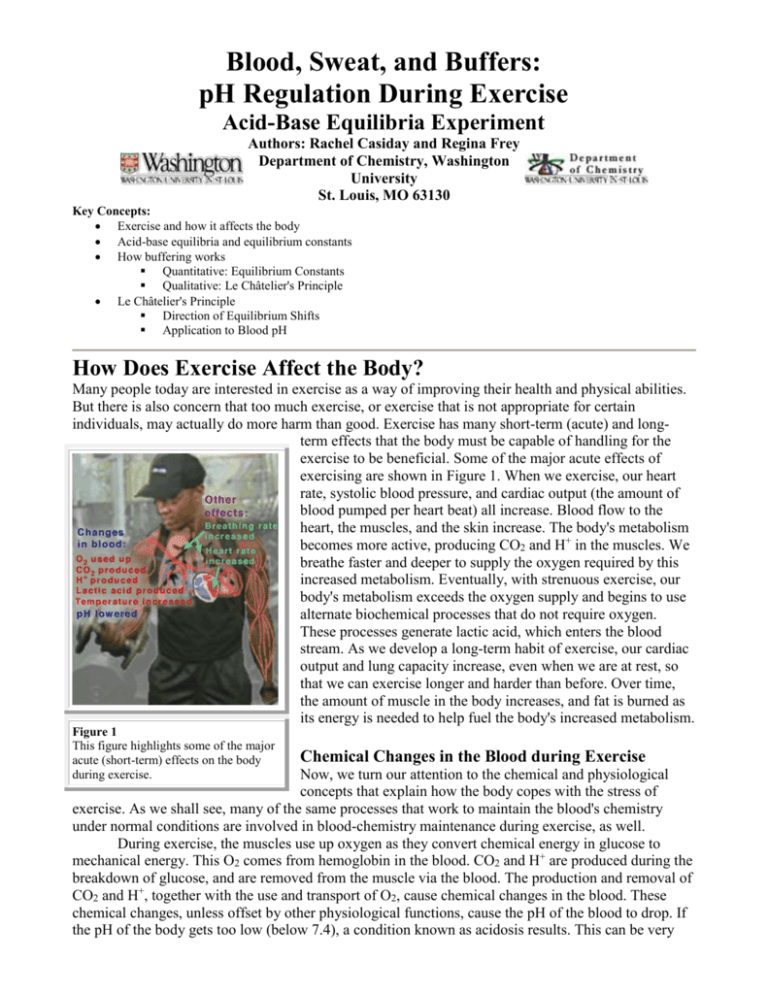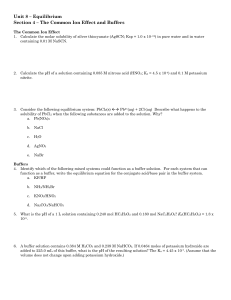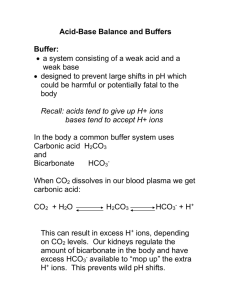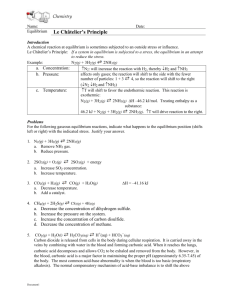
Blood, Sweat, and Buffers:
pH Regulation During Exercise
Acid-Base Equilibria Experiment
Authors: Rachel Casiday and Regina Frey
Department of Chemistry, Washington
University
St. Louis, MO 63130
Key Concepts:
Exercise and how it affects the body
Acid-base equilibria and equilibrium constants
How buffering works
Quantitative: Equilibrium Constants
Qualitative: Le Châtelier's Principle
Le Châtelier's Principle
Direction of Equilibrium Shifts
Application to Blood pH
How Does Exercise Affect the Body?
Many people today are interested in exercise as a way of improving their health and physical abilities.
But there is also concern that too much exercise, or exercise that is not appropriate for certain
individuals, may actually do more harm than good. Exercise has many short-term (acute) and longterm effects that the body must be capable of handling for the
exercise to be beneficial. Some of the major acute effects of
exercising are shown in Figure 1. When we exercise, our heart
rate, systolic blood pressure, and cardiac output (the amount of
blood pumped per heart beat) all increase. Blood flow to the
heart, the muscles, and the skin increase. The body's metabolism
becomes more active, producing CO2 and H+ in the muscles. We
breathe faster and deeper to supply the oxygen required by this
increased metabolism. Eventually, with strenuous exercise, our
body's metabolism exceeds the oxygen supply and begins to use
alternate biochemical processes that do not require oxygen.
These processes generate lactic acid, which enters the blood
stream. As we develop a long-term habit of exercise, our cardiac
output and lung capacity increase, even when we are at rest, so
that we can exercise longer and harder than before. Over time,
the amount of muscle in the body increases, and fat is burned as
its energy is needed to help fuel the body's increased metabolism.
Figure 1
This figure highlights some of the major
acute (short-term) effects on the body
during exercise.
Chemical Changes in the Blood during Exercise
Now, we turn our attention to the chemical and physiological
concepts that explain how the body copes with the stress of
exercise. As we shall see, many of the same processes that work to maintain the blood's chemistry
under normal conditions are involved in blood-chemistry maintenance during exercise, as well.
During exercise, the muscles use up oxygen as they convert chemical energy in glucose to
mechanical energy. This O2 comes from hemoglobin in the blood. CO2 and H+ are produced during the
breakdown of glucose, and are removed from the muscle via the blood. The production and removal of
CO2 and H+, together with the use and transport of O2, cause chemical changes in the blood. These
chemical changes, unless offset by other physiological functions, cause the pH of the blood to drop. If
the pH of the body gets too low (below 7.4), a condition known as acidosis results. This can be very
serious, because many of the chemical reactions that occur in the body, especially those involving
proteins, are pH-dependent. Ideally, the pH of the blood should be maintained at 7.4. If the pH drops
below 6.8 or rises above 7.8, death may occur. Fortunately, we have buffers in the blood to protect
against large changes in pH.
How Chemicals Are Exchanged in the Body
All cells in the body continually exchange chemicals (e.g.,nutrients, waste products, and ions)
with the external fluid surrounding them (Figure 2). This external fluid, in turn, exchanges chemicals
with the blood being pumped throughout the body. A dominant mode of exchange between these fluids
(cellular fluid, external fluid, and blood) is diffusion through membrane channels, due to a
concentration gradient associated with the contents of the fluids. (Recall your experience with
concentration gradients in the "Membranes, Proteins, and Dialysis" experiment.) Hence, the chemical
composition of the blood (and therefore of the external fluid) is extremely important for the cell. If, for
instance, the pH of the blood and external fluid is too low (too many H+ ions), then an excess of H+
ions will enter the cell. As mentioned above, maintaining the proper pH is critical for the chemical
reactions that occur in the body. In order to maintain the proper chemical composition inside the cells,
the chemical composition of the fluids outside the cells must be kept relatively constant. This
constancy is known in biology as homeostasis.
The body has a wide array of mechanisms to
maintain homeostasis in the blood and extracellular
fluid. The most important way that the pH of the
blood is kept relatively constant is by buffers
dissolved in the blood. Other organs help enhance
the homeostatic function of the buffers. The kidneys
help remove excess chemicals from the blood, as
discussed in the Kidney Dialysis tutorial. It is the
kidneys that ultimately remove (from the body) H+
ions and other components of the pH buffers that
build up in excess. Acidosis that results from failure
of the kidneys to perform this excretory function is
known as metabolic acidosis. However, excretion
by the kidneys is a relatively slow process, and may
take too long to prevent acute acidosis resulting from
a sudden decrease in pH (e.g., during exercise). The
lungs provide a faster way to help control the pH of
the blood. The increased-breathing response to
Figure 2
exercise helps to counteract the pH-lowering effects
This is a schematic diagram showing the flow
of exercise by removing CO2, a component of the
of species across membranes between the
principal pH buffer in the blood. Acidosis that results
cells, the extracellular fluid, and the blood in
from failure of the lungs to eliminate CO2 as fast as
the capillaries.
it is produced is known as respiratory acidosis.
How Buffers Work: A Quantitative View
The kidneys and the lungs work together to help maintain a blood pH of 7.4 by affecting the
components of the buffers in the blood. Therefore, to understand how these organs help control the pH
of the blood, we must first discuss how buffers work in solution.
Acid-base buffers confer resistance to a change in the pH of a solution when hydrogen ions
(protons) or hydroxide ions are added or removed. An acid-base buffer typically consists of a weak
acid, and its conjugate base (salt) (see Equations 2-4 in the blue box, below). Buffers work because
the concentrations of the weak acid and its salt are large compared to the amount of protons or
hydroxide ions added or removed. When protons are added to the solution from an external source,
some of the base component of the buffer is converted to the weak-acid component (thus using up
most of the protons added); when hydroxide ions are added to the solution (or, equivalently, protons
are removed from the solution; see Equations 8-9 in the blue box, below), protons are dissociated from
some of the weak-acid molecules of the buffer, converting them to the base of the buffer (and thus
replenishing most of the protons removed). However, the change in acid and base concentrations is
small relative to the amounts of these species present in solution. Hence, the ratio of acid to base
changes only slightly. Thus, the effect on the pH of the solution is small, within certain limitations on
the amount of H+ or OH- added or removed.
The Carbonic-Acid-Bicarbonate Buffer in the Blood
By far the most important buffer for maintaining acid-base balance in the blood is the carbonicacid-bicarbonate buffer. The simultaneous equilibrium reactions of interest are:
(
We are interested in the change in the pH of the blood; therefore, we want an expression for the
concentration of H+ in terms of an equilibrium constant (see blue box, below) and the concentrations of
the other species in the reaction (HCO3-, H2CO3, and CO2).
The pH of the buffered solution (i.e., the blood) is dependent only on the ratio of the amount of
CO2 present in the blood to the amount of HCO3- (bicarbonate ion) present in the blood (at a given
temperature, so that pK remains constant). This ratio remains relatively constant, because the
concentrations of both buffer components (HCO3- and CO2) are very large, compared to the amount of
H+ added to the blood during normal activities and moderate exercise. When H+ is added to the blood
as a result of metabolic processes, the amount of HCO3- (relative to the amount of CO2) decreases;
however, the amount of the change is tiny compared to the amount of HCO3- present in the blood. This
optimal buffering occurs when the pH is within approximately 1 pH unit from the pK value for the
buffering system, i.e., when the pH is between 5.1 and 7.1.
However, the normal blood pH of 7.4 is outside the optimal buffering range; therefore, the addition
of protons to the blood due to strenuous exercise may be too great
for the buffer alone to effectively control the pH of the blood.
When this happens, other organs must help control the amounts of
CO2 and HCO3- in the blood. The lungs remove excess CO2 from
the blood (helping to raise the pH via shifts in the equilibrium),
and the kidneys remove excess HCO3- from the body (helping to
lower the pH). The lungs' removal of CO2 from the blood is
somewhat impeded during exercise when the heart rate is very
rapid; the blood is pumped through the capillaries very quickly,
and so there is little time in the lungs for carbon dioxide to be
exchanged for oxygen. The ways in which these three organs help
to control the blood pH through the bicarbonate buffer system are
highlighted in Figure 3, below.
Why the Optimal Buffering Capacity Is at pH=pK
Why is the buffering capacity of the carbonic-acidbicarbonate buffer highest when the pH is close to the pK value,
but lower at normal blood pH? The answer to this question lies in
the shape of the titration curve for the buffer, which is shown in
Figure 4, below.
Titration Curve for the Bicarbonate-Buffer System
In this plot, the vertical axis shows the pH of the buffered solution
(in this case, the blood). The horizontal axis shows the
composition of the buffer: on the left-hand side of the plot, most
of the buffer is in the form of carbonic acid or carbon dioxide, and on the right-hand side of the plot,
most of the buffer is in the form of bicarbonate ion. Note that as acid is added, the pH decreases and
Figure 3
This figure shows the major organs that
help control the blood concentrations of
CO2 and HCO3-, and thus help control
the pH of the blood.
Removing CO2 from the blood helps
increase the pH.
Removing HCO3- from the blood helps
lower the pH.
the buffer shifts toward greater H2CO3 and CO2 concentration. Conversely, as base is added, the pH
increases and the buffer shifts toward greater HCO3- concentration (Equation 10).
The slope of the curve is flattest where the
pH is equal to the pK value (6.1) for the buffer.
Here, the buffering capacity is greatest because
a shift in the relative concentrations of
bicarbonate and carbon dioxide produces only a
small change in the pH of the solution.
However, at pH values higher than 7.1, the slope
of the curve is much higher. Here, a shift in the
relative concentrations of bicarbonate and
carbon dioxide produces a large change in the
pH of the solution. Hence, at the physiological
blood pH of 7.4, other organs must help to
control the amounts of HCO3- and CO2 in the
blood to keep the pH relatively constant, as
described above.
Figure 4
This is the titration curve for the carbonic-acid-bicarbonate
buffer. Note that the pH of the blood (7.4) lies outside the
region of greatest buffering capacity (green).
Note: The percent buffer in the form of HCO3- is
Other pH-Buffer Systems in the Blood
Other buffers perform a more minor role
than the carbonic-acid-bicarbonate buffer in
given by the formula:
regulating the pH of the blood. The phosphate
buffer consists of phosphoric acid (H3PO4) in
equilibrium with dihydrogen phosphate ion
(H2PO4-) and H+. The pK for the phosphate
buffer is 6.8, which allows this buffer to
function within its optimal buffering range at
physiological pH. The phosphate buffer only plays a minor role in the blood, however, because H3PO4
and H2PO4- are found in very low concentration in the blood. Hemoglobin also acts as a pH buffer in
the blood. Recall from the "Hemoglobin" tutorial from Chem 151 that hemoglobin protein can
reversibly bind either H+ (to the protein) or O2 (to the Fe of the heme group), but that when one of
these substances is bound, the other is released (as explained by the Bohr effect). During exercise,
hemoglobin helps to control the pH of the blood by binding some of the excess protons that are
generated in the muscles. At the same time, molecular oxygen is released for use by the muscles.
Equilibrium Shifts: A Qualitative View
The above discussion treats changes in pH quantitatively. These changes in pH can be
described qualitatively, also. A qualitative view is very useful for predicting how the pH will change in
response to external conditions (such as exercise). The principle used for this qualitative view is known
as Le Châtelier's Principle.
Le Châtelier's Principle
When a reactant or product of an equilibrium reaction is added to a solution that is at
equilibrium, the added species will react to change the concentrations of the reactants and products in
the solution until a new equilibrium is established (but the ratio of the concentrations given in the mass
action expression is the same, because the equilibrium constant, K, is a constant at a given
temperature). This process is known as a shift in the equilibrium. In 1884, Henri Le Châtelier
developed a rule to predict how a system in equilibrium will shift when the conditions of the system
are changed. Although this rule can oversimplify the changes that occur in certain situations, it is a
powerful and useful tool for predicting the direction of an equilibrium shift. Le Châtelier's Principle
states that "if a change in conditions ([an external] 'stress') is imposed on a system at equilibrium,
the equilibrium position will shift in a direction that tends to reduce that change in conditions"
(Zumdahl, 208). For example, if the concentration of one of the products of an equilibrium reaction is
increased in a solution that was at equilibrium (prior to the concentration increase), the equilibrium
will shift so as to reduce the concentration of the product, i.e.,more reactant will be generated. Of
course, the reverse equilibrium shift would occur when the concentration of a product is decreased.
The effect of a temperature change can also be predicted by Le Châtelier's Principle. (In the case of a
change in temperature, the equilibrium constant actually changes.) If a reaction is exothermic, "heat" is
treated as a "product" (e.g., A + B -> C + D + "heat"). If a reaction is endothermic, "heat" is treated as
a "reactant" (e.g., "heat" + A + B -> C + D). Increasing the temperature can be thought of as increasing
the amount of "heat" in the reaction. Examples of external stresses and the equilibrium shifts predicted
by Le Châtelier's Principle are shown in the purple table below.
External Stress
Predicted Equilibrium Shift
Change in pressure
Affects gases only.
Concentration of reactant(s)
increased
Equilibrium shifts toward products (to
the right).
Concentration of product(s)
increased
Equilibrium shifts toward reactants (to
the left).
Temperature increased
(exothermic reaction)
Equilibrium shifts toward reactants (to
the left).
Temperature increased
(endothermic reaction)
Equilibrium shifts toward products (to
the right).
Example: Removal of Bicarbonate by the Kidneys
Le Châtelier's Principle can be used to explain how the kidneys help prevent excessively high
pH (a condition known as alkalosis). When the pH of the blood is too high, the kidneys remove
bicarbonate ion (HCO3-) from the blood. As the kidneys decrease the blood's concentration of HCO3-,
the equilibrium reaction in Equation 10 is shifted toward the left to compensate for the loss in HCO3-,
according to Le Châtelier's Principle. When the equilibrium shifts to the left, more H+ ions are
generated together with HCO3- ions. As a result, the pH decreases.
Summary: What Happens to the Blood During Exercise?
When you exercise, many of the processes that we have discussed in this and in previous tutorials work
together to determine how the pH of the blood will change (Figure 5).
Figure 5
This diagram shows the diffusion directions for H+, CO2, and O2
between the blood and the muscle cells during exercise. The resulting
concentration changes affect the buffer equilibria, shown in the upper
right-hand corner of the diagram (yellow).
The following steps outline the processes that affect the buffers in the blood during exercise.
Hemoglobin carries O2 from the lungs to the muscles through the blood.
The muscles need more O2 than normal, because their metabolic activity is increased during
exercise. The amount of oxygen in the muscle is therefore depleted in the muscles, setting up a
concentration gradient between the muscle cells and the blood in the capillaries. Oxygen
diffuses from the blood to the muscles, via this concentration gradient.
The muscles produce CO2 and H+ as a result of increased metabolism, setting up concentration
gradients in the opposite direction from the O2 gradient.
The CO2 and H+ flow from the muscles to the blood, via these concentration gradients.
The buffering action of hemoglobin picks up the extra H+ and CO2.
If the amounts of H+ and CO2 exceed the capacity of hemoglobin, they affect the carbonic acid
equilibrium (Equation 10), as predicted by Le Châtelier's Principle or the quantitative treatment
in terms of equilibrium constants. As a result, the pH of the blood is lowered, causing acidosis.
The lungs and kidneys respond to pH changes by removing CO2, HCO3-, and H+ from the
blood.
Hence, the body has developed finely-tuned chemical processes (based on buffering and acid-base
equilibria) that work in combination to handle the changes that exercise produces.
References:
Brown, Lemay, and Bursten. Chemistry: the Central Science, 7th ed. p. 631.
Vander, A. et al. Human Physiology, 6th ed. WCB McGraw-Hill, Boston, 1994, p. 463-466, 492-3, 552-6.
Zumdahl. Chem. Principles, 4th ed.p. 192-5, 208-214.
Acknowledgements:
The authors thank Dewey Holten, Michelle Gilbertson, Jody Proctor and Carolyn Herman for many helpful suggestions in the writing of this tutorial.
The development of this tutorial was supported by a grant from the Howard Hughes Medical Institute, through the Undergraduate Biological Sciences
Education program, Grant HHMI# 71195-502005 to Washington University.
Copyright 1999, Washington University, All Rights Reserved.










